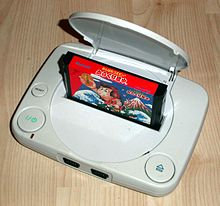PolyStation
 Close-up image of a PolyStation with a cartridge inserted (Ganbare Goemon! Karakuri Dōchū) | |
| Also known as | PolyStation II, PolyStation III, Super PolyStation, PolyStation 2, PolyStation 3; PS-Kid, Game Player, Extra TV Game, Play and Power, FunStation, PSMan, FunStation 3 |
|---|---|
| Type | Famiclone |
PolyStation was a counterfeit video game console and Nintendo Entertainment System hardware clone that closely resembles a Sony PlayStation, particularly the PS1 variant.[1] The cartridge slot of the PS1-clone systems is located under the lid which, on an original PlayStation, covers the disc drive.
History
[edit]The history of PolyStation began with Western businessman Ali Ahmad Zaioum, of Paraguayan-Lebanese origin. He also owns around 400 patents and trademarks supposedly created by him.[2] However, he was accused by the Paraguayan court of falsifying documents and information in order to obtain registration with the Ministry of Industry and Commerce of Paraguay.[3]
The console was very popular in the 2000s in many Latin American countries, mainly because it was sold at a low price.[4] In 2015, PolyStations proved to be popular in parts of Costa Rica.[5]
Variations of the PolyStation
[edit]PolyStation consoles are sold under many different names, including PS-Kid, Game Player, Play and Power, FunStation, Extra TV Game, and PSMan;[5] there are also a number of variations on the PolyStation name, such as PolyStation II, PolyStation III and Super PolyStation.[6][7]
Some of these consoles resemble the original PlayStation, others the PSone redesign, and others the PlayStation 2. Recent variations of the PolyStation resemble the PlayStation 3, some of which sold under the name FunStation 3.[8] Some variations include built-in unlicensed games, and in many cases these games are modified copies of licensed games.[9]
Other versions of the console include the PolyStation 2[10] and 3,[11] which are small versions of the PlayStation 2 and 3 and come with an attachable controller. They have a small LCD screen, and are playable handheld games.
References
[edit]- ^ Kanellos, Michael. "PlayStation vs. PolyStation". CNET. Archived from the original on 4 March 2016. Retrieved 22 January 2019.
- ^ http://www.dothnews.com.br. "Sony denuncia 'mega inventor' da fronteira que criou o Poly Station". www.douradosnews.com.br (in Brazilian Portuguese). Retrieved 2024-09-29.
{{cite web}}: External link in|last= - ^ "PolyStation: conheça o videogame que decepcionou muita criança". Tecmundo (in Brazilian Portuguese). 27 March 2022. Retrieved 27 January 2023.
- ^ Faria, Rodrigo (10 May 2013). "UOL Jogos testa o Polystation, videogame que mais 'engana' os pais". UOL Jogos (in Brazilian Portuguese). Retrieved 27 January 2023.
- ^ a b "La Polystation es la reina de las copias". La Nación (in Spanish). Archived from the original on 10 February 2022. Retrieved 10 February 2022.
- ^ GameVicio (2010-01-05). "Os famosos video games piratas". GameVicio (in Brazilian Portuguese). Retrieved 2023-07-21.
- ^ Thiago, por. "Você conhece o Polystation?". Retrieved 2023-07-21.
- ^ Saltalamacchia, Brandon (2019-07-04). "Polystation - Why & How Does This Fake Playstation Exist?". Retro Dodo. Retrieved 2023-10-04.
- ^ Justin Towell (2014-08-05). "DOALSHOCK? The most ludicrous game hardware knock-offs". gamesradar. Retrieved 2023-10-04.
- ^ "Mini PolyStation 2 PS2 knock-off". Engadget. Archived from the original on 2022-02-10. Retrieved 10 February 2022.
- ^ "Inevitably, the PolyStation 3". Engadget. Archived from the original on 2022-02-10. Retrieved 10 February 2022.
External links
[edit] Media related to Polystation at Wikimedia Commons
Media related to Polystation at Wikimedia Commons- PolyStation on the Nintendo Player database
